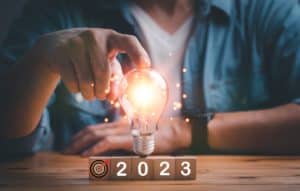As TBGers, we feel honored to work with clients who are dedicated to protecting our country from any sort of threat – including those who are forwarding innovation in robotics, machine learning, predictive computing and artificial intelligence.
Artificial intelligence is helping us fight the COVID-19 pandemic every second, in a variety of ways. A designed system can diagnose suspected cases within 20 seconds (approximately 45 times faster than human detection) with 96 percent accuracy. Could this be the answer to a faster understanding of the pathology of COVID-19 and perhaps an end to the pandemic?
Outbreak and Monitoring
Nine days before the WHO alerted the world to the emergence of a novel coronavirus, a Canada-based company, BlueDot– using machine learning to track the potential spread of infectious disease – detected an unusual cluster in Wuhan, China and sent the alert to clients around the world. The key data they used was one that may seem irrelevant – plane ticket airfares.
HealthMap, a website run by Boston Children’s Hospital, used artificial intelligence to scan social media, news reports, and internet search queries to detect and alert us to a new type of pneumonia on December 31, 2019.
Meanwhile, scientists in California are developing a system that can remotely monitor the health of the elderly and provide alerts if they show COVID symptoms or conditions that risk potential infection. Alexa by Amazon is now equipped with a feature where you can identify your risk of infection by providing information pertaining to travel history, symptoms, and other risk factors related to COVID-19. And in Asia, location-based messaging has been widely used to track travel, contact history, and traffic flow to help instantly alert people to the potential risk of infection while accumulating data for the prediction model.
Diagnosis and Cure
In the past several months, AI has also been used for screening, faster diagnosis, automated deliveries and laboratory drug discovery. Incorporating more than 5,000 confirmed coronavirus cases, Alibaba released an algorithm that can diagnose patients in 20 to 30 seconds using CT scans. This massive amount of medical information was later shared with medical professionals worldwide on an anonymous basis to help establish the database and refine the prediction.
Also, In addition, humanoid robots and unmanned drones are being used in a variety of ways. Some robots assist healthcare workers to deliver foods and medicines in hospitals or to quarantined families. Some are even used to entertain patients.
The Future
Apart from the achievements and benefits we get from machine learning, we can’t overlook the underlying risks. In 2009, Google launched Google Flu Trends to predict the outbreak of the flu in the United States. But the project stopped in 2015 due to instances where the algorithm overestimated the prevalence of flu.
Other critical concerns involve the privacy and security of medical data. Contact-tracing apps are essentially using personal smartphone or wearable devices data to provide real-time analysis and avoid potential exposure and spread of COVID. Maturing data transparency while protecting user privacy will remains and ongoing discussion in the next decade.
Despite these factors and concerns, this pandemic surely accelerated the growth of medical applications of AI, machine learning and other innovations. It is inevitable that artificial intelligence will continue to evolve. The combination of human knowledge and technology will help us find more solutions to the current crisis and react better in the next one.
Sources:


